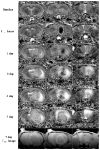High relaxivity trimetallic nitride (Gd3N) metallofullerene MRI contrast agents with optimized functionality
- PMID: 20218678
- PMCID: PMC2862638
- DOI: 10.1021/bc900375n
High relaxivity trimetallic nitride (Gd3N) metallofullerene MRI contrast agents with optimized functionality
Abstract
Water-soluble poly(ethylene glycol) (PEG) functionalized and hydroxylated endohedral trimetallic nitride metallofullerene derivatives, Gd(3)N@C(80)[DiPEG(OH)(x)], have been synthesized and characterized. The (1)H MRI relaxivities in aqueous solution were measured for the derivatives with four different molecular weights of PEG (350-5000 Da) at 0.35, 2.4, and 9.4 T. The 350/750 Da PEG derivatives have the highest relaxivities among the derivatives, 237/232 mM(-1) s(-1) for r(1) and 460/398 mM(-1) s(-1) for r(2) (79/77 mM(-1) s(-1) and 153/133 mM(-1) s(-1) based on Gd(3+) ion), respectively, at a clinical-range magnetic field of 2.4 T. These represent some of the highest relaxivities reported for commercial or investigational MRI contrast agents. Dynamic light scattering results confirm a larger average size for 350/750 Da PEGs derivatives (95/96 nm) relative to longer chain length derivatives, 5000 Da PEG derivatives (37 nm). Direct infusion of the optimized 350 Da PEG derivatives into live tumor-bearing rat brains demonstrated an initial uniform distribution, and hence, the potential for effective brachytherapy applications when the encapsulated Gd(3+) ions are replaced with radioactive (177)Lu.
Figures




Similar articles
-
Facile preparation of a new gadofullerene-based magnetic resonance imaging contrast agent with high 1H relaxivity.Bioconjug Chem. 2009 Jun;20(6):1186-93. doi: 10.1021/bc900051d. Bioconjug Chem. 2009. PMID: 19445504 Free PMC article.
-
Gd3N@C84(OH)x: a new egg-shaped metallofullerene magnetic resonance imaging contrast agent.J Am Chem Soc. 2014 Feb 12;136(6):2630-6. doi: 10.1021/ja412254k. Epub 2014 Feb 3. J Am Chem Soc. 2014. PMID: 24432974
-
Tri-gadolinium nitride PEGylated-hydroxylated endohedral metallofullerene.2008 Oct 28 [updated 2008 Dec 1]. In: Molecular Imaging and Contrast Agent Database (MICAD) [Internet]. Bethesda (MD): National Center for Biotechnology Information (US); 2004–2013. 2008 Oct 28 [updated 2008 Dec 1]. In: Molecular Imaging and Contrast Agent Database (MICAD) [Internet]. Bethesda (MD): National Center for Biotechnology Information (US); 2004–2013. PMID: 20641442 Free Books & Documents. Review.
-
Water-soluble gadofullerenes: toward high-relaxivity, pH-responsive MRI contrast agents.J Am Chem Soc. 2005 Jan 19;127(2):799-805. doi: 10.1021/ja044688h. J Am Chem Soc. 2005. PMID: 15643906
-
Gd@C82 Fullerenol.2008 Oct 31 [updated 2008 Dec 1]. In: Molecular Imaging and Contrast Agent Database (MICAD) [Internet]. Bethesda (MD): National Center for Biotechnology Information (US); 2004–2013. 2008 Oct 31 [updated 2008 Dec 1]. In: Molecular Imaging and Contrast Agent Database (MICAD) [Internet]. Bethesda (MD): National Center for Biotechnology Information (US); 2004–2013. PMID: 20641737 Free Books & Documents. Review.
Cited by
-
Metallofullerene-nanoplatform-delivered interstitial brachytherapy improved survival in a murine model of glioblastoma multiforme.Bioconjug Chem. 2012 Sep 19;23(9):1873-80. doi: 10.1021/bc300206q. Epub 2012 Aug 21. Bioconjug Chem. 2012. PMID: 22881865 Free PMC article.
-
Gain of a 500-fold sensitivity on an intravital MR contrast agent based on an endohedral gadolinium-cluster-fullerene-conjugate: a new chance in cancer diagnostics.Int J Med Sci. 2010 May 28;7(3):136-46. doi: 10.7150/ijms.7.136. Int J Med Sci. 2010. PMID: 20567614 Free PMC article.
-
Mn-porphyrin conjugated Au nanoshells encapsulating doxorubicin for potential magnetic resonance imaging and light triggered synergistic therapy of cancer.Theranostics. 2014 Jun 11;4(9):858-71. doi: 10.7150/thno.8818. eCollection 2014. Theranostics. 2014. PMID: 25057312 Free PMC article.
-
Magnetic Nanoclusters with Hydrophilic Spacing for Dual Drug Delivery and Sensitive Magnetic Resonance Imaging.J Mater Chem B. 2013;1(8):1142-1149. doi: 10.1039/C2TB00275B. J Mater Chem B. 2013. PMID: 25328679 Free PMC article.
-
Interactions between Endohedral Metallofullerenes and Proteins: The Gd@C60-Lysozyme Model.ACS Omega. 2018 Oct 22;3(10):13782-13789. doi: 10.1021/acsomega.8b01888. eCollection 2018 Oct 31. ACS Omega. 2018. PMID: 31458078 Free PMC article.
References
-
- Caravan P, Ellison JJ, McMurry TJ, Lauffer RB. Gadolinium(III) Chelates as MRI Contrast Agents: Structure, Dynamics, and Applications. Chem Rev. 1999;99:2293–2352. - PubMed
-
- Lauffer RB. Paramagnetic Metal Complexes as Water Proton Relaxation Agents for NMR Imaging: Theory and Design. Chem Rev. 1987;87:901–927.
-
- Sieber MA, Pietsch H, Walter J, Haider W, Frenzel T, Weinmann HJ. A preclinical study to investigate the development of nephrogenic systemic fibrosis: A possible role for gadolinium-based contrast media. Invest Radiol. 2008;43:65–75. - PubMed
-
- Grobner T. Gadolinium - a specific trigger for the development of nephrogenic fibrosing dermopathy and nephrogenic systemic fibrosis? Nephrol, Dial, Transplant. 2006;21:1104–1108. - PubMed
-
- Shu CY, Zhang EY, Xiang JF, Zhu CF, Wang CR, Pei XL, Han HB. Aggregation studies of the water-soluble gadofullerene magnetic resonance imaging contrast agent: [Gd@C82O6(OH)16(NHCH2CH2COOH)8]x. J Phys Chem B. 2006;110:15597–15601. - PubMed
Publication types
MeSH terms
Substances
Grants and funding
LinkOut - more resources
Full Text Sources
Other Literature Sources
Medical
Miscellaneous

